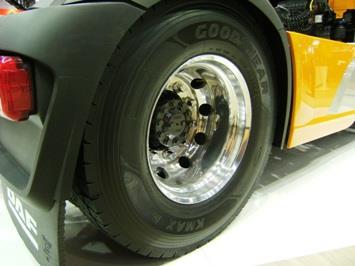
Goodyear Dunlop has "hit on a winning formula" for its premium Goodyear brand truck tyres with the FuelMax low rolling resistance range and the KMax high mileage range, according to commercial director Marc Preedy.
Speaking at the CV Show, Preedy said it was "great to be back after a period in the wilderness" with a stand that was "all about Goodyear tyres and what they can do".
"These tyres have been five or six years in the making," said Preedy (pictured below). "They are products that match customer requirements by delivering 35% improvement in longevity for the KMax and 10% lower rolling resistance for the FuelMax."
Goodyear has doubled its sales volumes in the UK in the last two years, taking share from both budget brands as operators trade up and from rival premium brands.
"Goodyear is focused on the premium sector and that is where we want to play," said Preedy. "I have the Goodyear, Dunlop, Fulda and Sava brands available, so I can attack the budget market with Sava and play in the mid range with Fulda. Everyone is now trading up - those who tried budget brands have found you buy cheap you buy twice."

Dunlop is now positioned as a premium retail product exclusively sold through tyre dealerships while Goodyear is targeted on big fleet deals. "We are not going out buying market share," insisted Preedy. "We know what we are good at and the companies that will fit with what we do."
Fleet customers now include BP, Elddis, Turners and Morrisons.
Preedy said larger operators were increasingly specifying low rolling resistance tyres as the lower overall costs were now being proven in real life operations. This trend has also been helped by an increasingly common policy of specifying all new tyres rather than retreads on drive and trailer as well as steer axles.
"There is a 25% fuel penalty from using retreads on the trailer axles," asserted Preedy. "Half of fuel savings come from the trailer tyres, 30% from the drive tyres and 20% from the steer."
But Preedy acknowledged it was still a long process to convince operators of the total cost of ownership benefits of fuel efficient tyres. "It takes 18 months just to get our rubber rolled in across a fleet," he said. "The variables are massive but we can put the scores up to show the savings are there."
While FuelMax is positioned as the most fuel efficient tyre for long haul operations, the KMax also offers 5% lower rolling resistance than the previous generation of regional tyre.
More operators are also preferring pence per km (ppk) contracts - even if they cost more with low rolling resistance tyres because the try's need replacing more often ppk gives certainty over running costs. "We quote more ppk contracts than pay as you go," confirmed Preedy. "Previously they were only for fleets with over 300 vehicles; now fleets of 200 also want ppk."
While tyre production costs have risen this year, the increases have not been as great as originally predicted and have now stabilised.
Looking ahead, Preedy said that while tyre R&D continues, the next stage of developments would be in related technologies such as tyre pressure monitoring systems (TPMS) and radio frequency ID tags.
"We have TPMS in a couple of fleets," he said. "No one size fits all however. It won't be cheap to roll out for big fleets and getting the trailer to talk to every tractor remains an issue. We still have to prove the benefits." While the benefits of correctly inflated tyres include better safety, the wear and fuel economy, these can also be achieved by a proper tyre maintenance regime, Preedy acknowledged.














